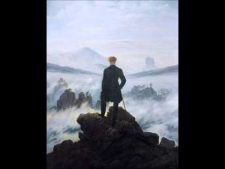Saturday, May 2, 1998
- 1997-1998 Season
- Symphony Orchestra
- Works Performed:
- Overture to Don Giovanni by W. A. Mozart
- Tod and Verklärung (Death and Transfiguration), Op. 24 by Richard Strauss
- The Three-Cornered Hat, Suites 1 and 2 by Manuel de Falla
- Venue: Shriver Hall
- Time: 8:00 pm
Concert Details

Program Notes
(“The Big Questions”)
Max Derrickson
Overture to Don Giovanni
W. A. Mozart (1756-1791)
Wolfgang A. Mozart (1756-1791) composed Don Giovanni in 1787. It is by any standard one of the great operas in history. It centers upon the story of the lecherous Don Giovanni (Don Juan) and his selfish, evil delight in wooing women. His appetites bring others much trouble, heartache, duels, and death. His exploits bring to him vengeful pursuit, but with the help of his comic servant Leporello, Giovanni narrowly escapes his wronged pursuers. The end of the opera, however, claims Giovanni to Hell’s raging fires.
Don Giovanni’s demise comes by way of stunningly dramatic music. His death is handed to him by a marble statue of one of Giovanni’s duel victims, the Commendatore. Mocking his victim’s fresh grave, Giovanni invites the Commendatore’s statue to dinner. Supernaturally, the statue accepts. The meeting then results in a demanding for Giovanni’s repentance from his worldly ways. His refusal brings Don Giovanni a host of devils dragging him into an eternity of flames. The music here, powerfully suspended rising and falling scalar passages, is also heard in the Overture, and is part of what makes it so memorable.
For all the seriousness of the opera, Mozart actually composed it as an “opera buffa (light-hearted, comedic)”. Only the genius and skill of Mozart could entwine comedy with eternal grief into one magnificent opera score, and he was assisted by the brilliant librettist Da Ponte. The joint skills of Da Ponte and Mozart also forged Le Nozze di Figaro and Cosi fan Tutte. All three operas are late masterpieces. The serious/humorous elements in these comic operas make for wonderfully varied and distinguished overtures, and the overtures themselves remain as much in the repertoire of the concert hall as the operas.
Tod und Verklärung (Death and Transfiguration)
Richard Strauss (1864-1949)
With Richard Georg Strauss (1864-1949), one finds music at the very height of the Romantic period: compositions for larger orchestras, emotional subjects, lavish colors and harmonies. Struass’ mature works, especially the fantastic operas Salome and Elektra, would help stretch the trends in musc to such degrees as to create a compositional reaction in the musical world known as the Second Viennese School (Schoenberg and serialism).
Tod und Verklärung (Death and Transfiguration, 1889) was written when Strauss was 25, and represents his earlier period of formal training and his fascination with the harmonies of Richard Wagner. Lush, romantic, and broad in scope, this symphonic poem (tone poem) depicts in detail the last moments of a dying man.
The timpani beats out a faint pulse rhythm that represents the dying man’s heart as he lies upon his death bed in great pain. The man muses upon the span of a life frustrated by unattainable Absolutes, yet a life not altogether unfavorable.
Three Cornered Hat Suites 1 & 2
Manuel de Falla (1876-1946)
The emergency of a Spanish National voice in the late 1800’s is owed to three wonderfully gifted Spanish composers and the exceptional scholar Felipe Pedrell. Teacher, scholar, and composer, Pedrell ignited the talents of Isaac Albeniz, Enrique Granados, and Manuel de Falla (Fie-ya) to fashion that voice.
In these composers’ works are the folk elements of Spain: the dances and the rhythms, the beautiful and melancholic melodies of Andalusia and the flamenco. Manuel de Falla (1876-1946) approached these elements by taking a cue from Claude Debussy, who used the ancient Byzantine church modes and impressions of folk elements in his Spanish-based works, rather than actually quoting folk material in melody.
The remarkable imagination and compositional ability of Falla are quite evident in the Three Corner Hat Suite. Originally, the work was composed as a pantomime (1916), but was revised as a ballet and premiered in London in 1919 under the baton of Ernest Ansermet with sets by Picasso. The two suites were created shortly thereafter.
Based on a classic novel by Pedro de Alarcon, the story is about a more or less innocent yet prevailing couple of a miller and his beautiful wife pitted against an adulterous and conniving Corregidor (resident magistrate) acting on his devilish impulses.
There is no doubt of the Three Cornered Hat Suites’ Spanish setting when one hears the familiar ornamentation of the melodies, the cante hondo (a melody of repeated notes surrounded by apoggiaturas), the fandangos (dance), the highly syncopated farruca, and the lively jota (dance, especially at the closing of the piece). The uniqueness of the piece from Falla’s other works is its light-hearted treatment of a serious issue. Also unusual for Falla is the relatively rare folk quotations (and one quote from Beethoven). It is nonetheless typical of Manuel de Falla in its brilliant rhythms and coloristic instrumentation, its variety and quick pacing, and its impressionistic Spanish melodies and guitar chord harmonies.
